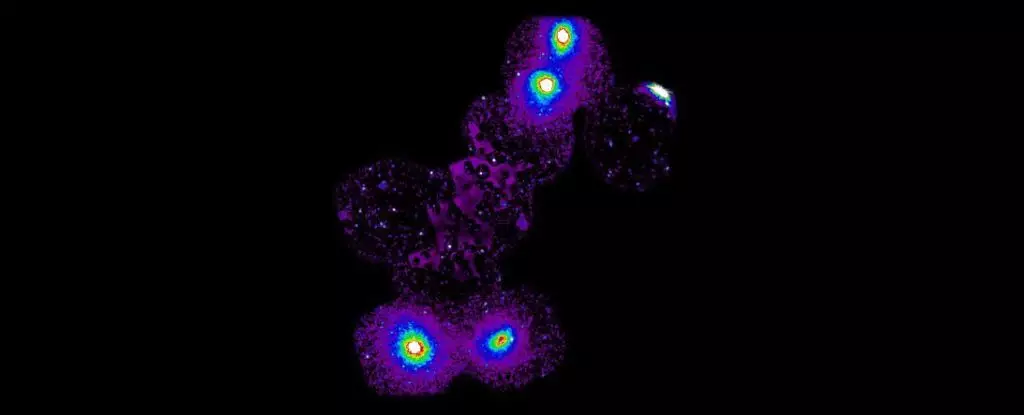Recent advancements in astrophysics have shed light on one of the most tantalizing enigmas of modern cosmology: the missing matter in the universe. New observations from the Shapley Supercluster, a colossal cluster of galaxies containing about 8,000 galaxies, have revealed a remarkable structural component that could account for this elusive matter. Utilizing sophisticated X-ray telescopic technology, scientists have discovered an extraordinary filament of hot gas that stretches an astonishing 23 million light-years. This finding not only challenges existing paradigms but also reaffirms theoretical models that have long been debated in the scientific community.
The astrophysicist Konstantinos Migkas at Leiden Observatory remarked, “For the first time, our results closely match what we see in our leading model of the cosmos – something that’s not happened before.” This assertion marks a significant milestone, as the correlation between observation and simulation may generate a new foundation upon which to reconstruct our understanding of the universe.
The Dual Nature of Cosmic Matter
At the heart of this discussion lies the distinction between normal matter and dark matter. Approximately 15% of the universe is constituted of ordinary matter — the protons, neutrons, and electrons we are familiar with. The remaining 85% is identified as dark matter, a type that has eluded direct observation yet exerts gravitational influence throughout the cosmos. For decades, astrophysicists have grappled with the disparity between the estimated quantities of normal matter shortly after the Big Bang and the observable matter today.
The Cosmic Microwave Background (CMB), the remnant radiation from the Big Bang, provides an essential clue regarding the matter present immediately after the universe’s birth. Indeed, the quantities predicted suggest that the current observable universe should include a substantial amount of normal matter that we fail to detect — a situation that raises the question: where did it go?
The Intergalactic “Superhighway”
Increasing evidence suggests that vast amounts of this missing matter reside in intergalactic space, woven into the fabric of the cosmic web — a network of filaments that interconnects galaxies and clusters. These filaments, while elusive, act as cosmic highways for the flow and distribution of matter across vast cosmic expanses. It is in this subtle, yet crucial role that the newly discovered filament of hot gas could be pivotal in resolving the mystery.
With unprecedented collaboration between observation satellites, specifically the retired Suzaku and the operational XMM-Newton, researchers have made strides in identifying this filament. The Suzaku satellite, known for its ability to detect faint X-rays over extensive areas, played a vital role, while the XMM-Newton instrument excelled in isolating bright X-ray sources that could distort observations. By leveraging the strengths of both tools, researchers could isolate and analyze the glow of gas within this filament, confirming its existence and essential characteristics.
Validating Theoretical Predictions
What sets this discovery apart is not merely its scale but the way it aligns with existing theoretical models of the universe. The filament discovered is not an anomaly; it fulfills the predictions made by simulations of the cosmos, exhibiting characteristics anticipated based on current cosmological theories. With a temperature exceeding 10 million degrees Celsius, this structure contains enough material to fill ten Milky Way galaxies, highlighting the vastness of our universe’s hidden components.
Norbert Schartel, a project scientist associated with XMM-Newton, states, “This research is a great example of collaboration between telescopes and creates a new benchmark for how to spot the light coming from the faint filaments of the cosmic web.” By establishing this benchmark, future investigations may provide further insights into the elusive nature of dark matter and normal matter, potentially guiding us toward a more comprehensive understanding of the structure and dynamics of the universe.
Looking Ahead: Implications for Future Research
The implications of this discovery reverberate through various domains of astrophysics. As scientists grapple with the mysteries of dark matter and cosmic evolution, this finding serves as a pivotal moment that may redefine categorically how we pursue astronomical studies. It emphasizes the importance of collaborative efforts in scientific research, demonstrating how varied tools and methodologies can lead to significant advancements in understanding.
This breakthrough should ignite curiosity and motivate future explorations with even more advanced technology. The quest for knowledge regarding the universe’s hidden facets continues, reminding us that beneath the vast cosmic silence, there lie mysteries waiting to be unraveled. Our journey through the cosmos is far from over, and with each new discovery, we inch closer to answering the age-old question of what constitutes our universe.


Leave a Reply